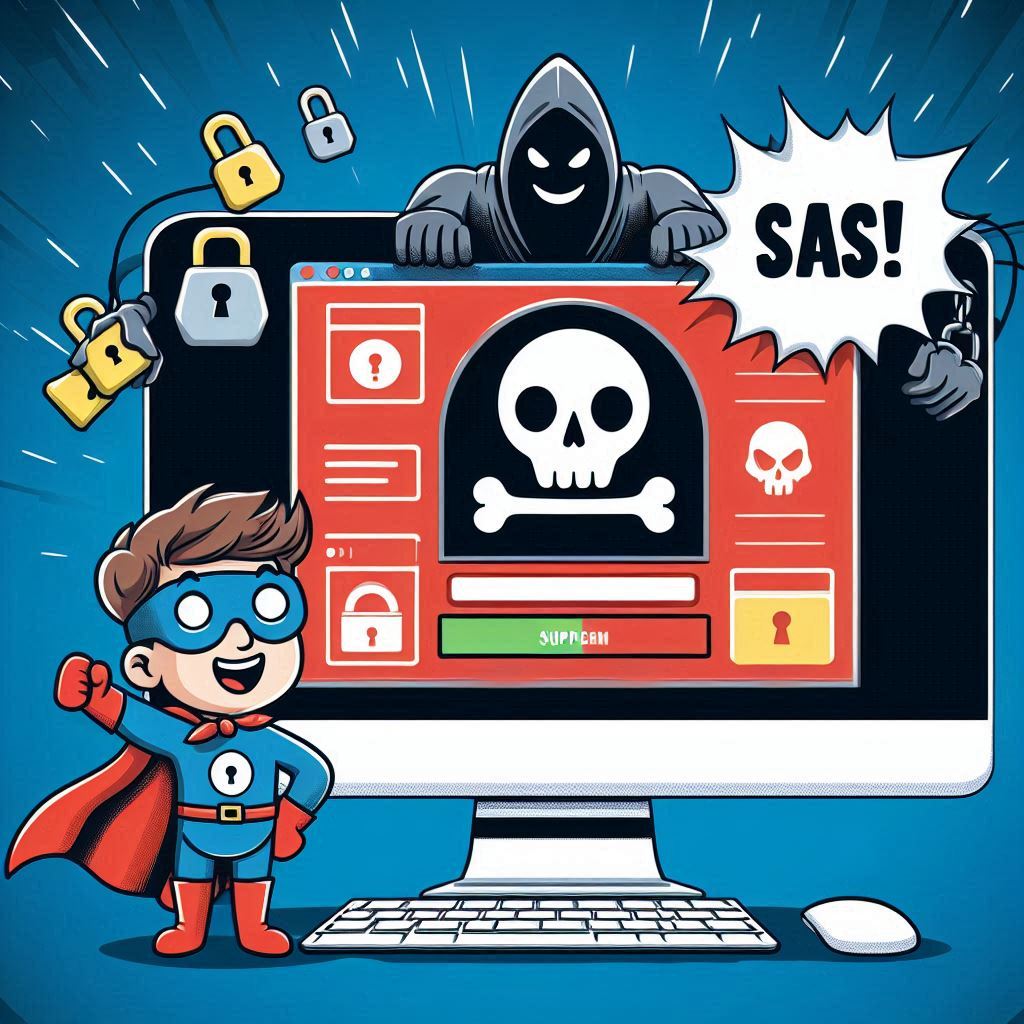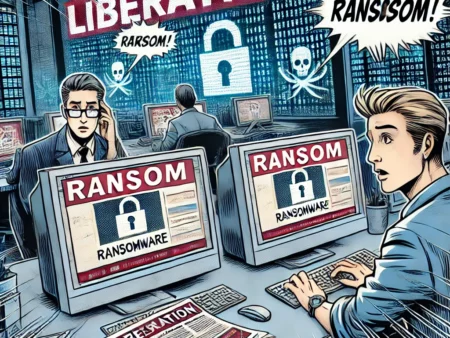
Ransomware has become one of the most significant and damaging threats in the cybersecurity landscape today. The rise of ransomware attacks has targeted organizations of all sizes, including government agencies, small businesses, and individual users, often resulting in devastating financial losses and operational downtime. With ransomware’s growing sophistication and frequency, it is essential to understand how these attacks work, the types of ransomware that exist, and the best strategies for protecting against them.
This article will delve into the ransomware threat, providing a comprehensive overview of its key characteristics, attack vectors, and defensive measures.
What is Ransomware?
Ransomware is a type of malware designed to block access to a computer system or encrypt data, holding it hostage until the victim pays a ransom. The payment is usually demanded in cryptocurrency, making it difficult to trace the attackers. Once the ransomware is deployed, users typically see a message demanding payment in exchange for the decryption key or access to their data.
The increasing prevalence of ransomware attacks, such as WannaCry, Ryuk, and REvil, has positioned ransomware as one of the top cyber threats in recent years. Businesses and individuals alike face severe consequences if they are unprepared, including loss of sensitive data, reputational damage, and financial losses. The global ransomware damage costs are expected to surpass $20 billion by 2024, highlighting the urgency to understand and address this threat.
How Ransomware Works: The Lifecycle of an Attack
Ransomware follows a predictable lifecycle, beginning with the initial infection and concluding with either the restoration of the encrypted data or the complete loss of access. Here’s how it typically unfolds:
Initial Infection (Attack Vectors): Ransomware infections can occur through several attack vectors, but the most common are phishing emails, malicious attachments, and exploiting vulnerabilities in outdated software. Attackers use social engineering techniques, tricking users into clicking on malicious links or downloading infected files.
Payload Deployment: Once the ransomware is installed on a system, it deploys the malicious payload. This payload spreads rapidly, encrypting files and often compromising the entire network. Advanced ransomware uses lateral movement techniques to infiltrate connected systems and servers.
File Encryption: After the payload is deployed, the ransomware begins encrypting the victim’s files using sophisticated encryption algorithms like AES-256 or RSA-2048. These algorithms are virtually unbreakable without the correct decryption key, making it impossible for victims to access their data without complying with the ransom demand.
Ransom Demand: After encryption, victims are presented with a ransom note. Attackers usually provide instructions on how to make the payment in Bitcoin or other cryptocurrencies. Some ransomware variants, such as Dharma or Maze, use double extortion tactics, threatening to leak sensitive data if the ransom is not paid.
Communication with the Attacker: In some cases, victims are required to communicate with the attackers via the dark web or other encrypted communication channels to receive further instructions or negotiate the ransom amount.
Decryption or Data Loss: If the victim pays the ransom, they may receive a decryption key to restore their files, though there is no guarantee. Many cybersecurity experts advise against paying the ransom, as it funds criminal enterprises and may encourage future attacks.
Types of Ransomware: A Breakdown of the Most Common Variants
Ransomware comes in various forms, each with unique characteristics and attack methods. The following are the most prevalent types of ransomware in the wild today:
Crypto Ransomware (Encrypting Ransomware): The most common type of ransomware, crypto ransomware, encrypts a victim’s files, rendering them inaccessible until a ransom is paid. Notable examples include WannaCry and CryptoLocker. These strains of ransomware often use asymmetric encryption to lock data.
Locker Ransomware: Unlike crypto ransomware, which encrypts files, locker ransomware locks users out of their devices entirely. Victims cannot access their operating systems or any applications until they pay the ransom. Reveton and WinLocker are examples of this type of ransomware.
Scareware: Scareware mimics legitimate software, displaying fake warnings about malware infections or security vulnerabilities to scare users into paying for unnecessary or fake protection. Defru and MSIL/LockScreen are examples of scareware.
Doxware (Extortionware): In doxware attacks, the attackers threaten to leak sensitive personal or corporate data unless the ransom is paid. This type of ransomware leverages the fear of reputational damage or regulatory fines to coerce victims into compliance.
Ransomware-as-a-Service (RaaS): RaaS has emerged as a dominant business model within the ransomware ecosystem. It allows attackers to lease ransomware tools and services from more experienced cybercriminals. This has led to a surge in ransomware attacks, as even less skilled attackers can launch sophisticated campaigns. Popular RaaS operations include REvil and DarkSide.
Ransomware Attack Vectors: How Attackers Infiltrate Systems
Understanding the common entry points for ransomware attacks is crucial for preventing them. Some of the most prevalent attack vectors include:
Phishing Emails: Phishing is the most common vector for ransomware attacks. Attackers use deceptive emails to trick users into clicking on malicious links or downloading infected attachments. These emails are often designed to appear as legitimate communications from trusted organizations or colleagues, employing social engineering to lower the target’s guard.
Vulnerability Exploitation: Attackers often exploit known vulnerabilities in software or operating systems to gain unauthorized access to a network. The EternalBlue exploit, for example, was used in the infamous WannaCry ransomware attack to spread the malware across unpatched Windows systems.
Remote Desktop Protocol (RDP): RDP is commonly used for remote access to systems, but if poorly secured, it can be a gateway for ransomware attacks. Attackers often use brute-force techniques to crack weak RDP credentials or exploit vulnerabilities in outdated RDP software.
Drive-By Downloads: In a drive-by download attack, ransomware is delivered through compromised websites or malicious ads. When a user visits an infected site, the ransomware is downloaded and installed without their knowledge.
Supply Chain Attacks: In supply chain ransomware attacks, attackers target trusted third-party vendors or service providers with access to the victim’s systems. The Kaseya ransomware attack in 2021 is an example of how attackers compromised a software provider to deploy ransomware across hundreds of businesses.
The Financial and Operational Impact of Ransomware
Ransomware is not only a cybersecurity issue but a significant financial threat to businesses. According to reports, ransomware costs have exceeded $1.85 billion globally, with an average ransom payment of over $300,000. However, the costs of a ransomware attack go beyond the ransom itself. Some of the key financial and operational impacts include:
Downtime: Organizations often experience extended downtime during a ransomware attack as IT teams work to restore systems and recover data. This downtime can cost businesses millions in lost productivity and revenue, especially in industries like healthcare, where operational continuity is critical.
Data Loss: Even if a ransom is paid, there is no guarantee that data will be fully restored. In some cases, the decryption process may fail, or attackers may withhold part of the data as leverage for further demands.
Reputational Damage: Ransomware attacks can cause severe reputational damage, especially for companies handling sensitive customer information. Data breaches resulting from ransomware attacks can lead to a loss of customer trust and long-term harm to a company’s brand image.
Legal and Regulatory Consequences: Depending on the industry and region, ransomware attacks can trigger regulatory fines or lawsuits. For example, under GDPR, organizations can face significant penalties if they fail to protect customer data.
High-Profile Ransomware Attacks: A Look at Recent Cases
Ransomware has been responsible for some of the most significant cyberattacks in recent history. Here are a few notable cases:
WannaCry (2017): One of the most infamous ransomware attacks, WannaCry exploited the EternalBlue vulnerability to spread across Windows systems worldwide, causing billions of dollars in damages. The attack crippled the UK’s National Health Service (NHS) and affected over 200,000 computers across 150 countries.
Colonial Pipeline (2021): The ransomware attack on Colonial Pipeline, one of the largest fuel pipelines in the U.S., resulted in widespread fuel shortages across the East Coast. The company paid a ransom of $4.4 million in Bitcoin to restore operations, though much of the payment was later recovered by the FBI.
Best Practices to Prevent Ransomware Attacks
JBS Foods (2021): JBS Foods, one of the world’s largest meat processing companies, was hit by a REvil ransomware attack, forcing the shutdown of several plants and causing significant disruption to global food supply chains. The company paid an $11 million ransom to regain access to its systems.
While ransomware attacks are increasingly sophisticated, organizations can take several proactive steps to reduce their risk:
Regular Backups: Ensuring that data is regularly backed up to secure, off-site locations is one of the most effective ways to mitigate the damage of a ransomware attack. These backups should be encrypted and isolated from the main network to prevent them from
Implement Strong Email Security: As phishing remains the most common vector for ransomware, businesses should employ email filtering and anti-phishing solutions to block malicious emails before they reach employees. Additionally, conducting regular security awareness training can help employees recognize and avoid phishing attempts.
Use Multi-Factor Authentication (MFA): Enforcing MFA can protect sensitive systems from being accessed through stolen or compromised credentials. This extra layer of security requires users to verify their identity through multiple methods, such as a password and a mobile authentication app, reducing the chance of an attacker infiltrating the network.
Network Segmentation: Isolating critical systems and sensitive data through network segmentation can prevent the lateral movement of ransomware within a compromised network. This practice ensures that if one part of the network is infected, other parts remain protected, minimizing the overall damage.
Endpoint Detection and Response (EDR): Advanced EDR solutions can detect and respond to suspicious activity, such as ransomware attempting to encrypt files. These tools monitor endpoints in real-time, enabling security teams to act quickly and block threats before they can fully execute.
Zero Trust Architecture: Adopting a Zero Trust security model, which assumes that all users, devices, and applications are untrusted by default, can significantly improve an organization’s defenses against ransomware. This model verifies the identity of every entity attempting to access network resources, ensuring that malicious actors are blocked even if they manage to bypass other security measures.
The Future of Ransomware: What to Expect
Ransomware will continue to evolve as attackers develop more sophisticated tactics and tools. The rise of Ransomware-as-a-Service (RaaS) platforms has already lowered the barrier to entry for cybercriminals, resulting in an increase in attacks across various industries. As cyber extortion techniques become more advanced, we may see the following trends in the ransomware landscape:
Double and Triple Extortion: Attackers may increasingly turn to double extortion, where they encrypt data and threaten to leak it, and even triple extortion, where they also target customers, partners, or other stakeholders of the victim organization.
Ransom Demands Increasing: With the success of high-profile ransomware attacks, ransom demands have skyrocketed, and this trend is expected to continue. Attackers are learning that targeting large corporations and critical infrastructure can result in multi-million-dollar payouts.
Targeting Critical Infrastructure: Healthcare, energy, and government sectors will remain prime targets for ransomware attacks, as the potential for disruption and financial loss is significant. These sectors, often running legacy systems, are especially vulnerable to ransomware exploits.
Increased Regulation and Law Enforcement Collaboration: Governments worldwide are beginning to crack down on ransomware gangs, introducing new legislation and increasing law enforcement collaboration. Efforts such as international task forces and ransomware-specific sanctions aim to disrupt the financial and operational networks that support these cybercriminals.
Conclusion
Ransomware is a persistent and growing threat that shows no signs of slowing down. As businesses and individuals increasingly rely on digital systems and data, they must take proactive steps to protect themselves against ransomware attacks. By adopting best practices such as regular backups, patch management, strong email security, and the implementation of multi-factor authentication, organizations can significantly reduce their exposure to this form of cyber extortion.
Furthermore, as ransomware continues to evolve, staying informed about the latest trends, attack vectors, and defensive technologies is crucial. Cybersecurity professionals and organizations must remain vigilant and prepared, investing in both the technology and the human resources necessary to detect, respond to, and recover from ransomware attacks.
In a world where data is one of the most valuable assets, protecting it from the ever-growing ransomware threat should be a top priority for all.



























